 General
General  General Archive
General Archive  Cleveland Sports Vault: Joie Chitwood’s Thrill Show Comes to Town
Cleveland Sports Vault: Joie Chitwood’s Thrill Show Comes to Town
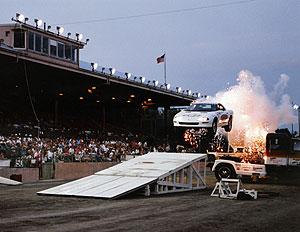 The public knew of the Joie Chitwood Thrill Show mostly by reputation, I think. It had been featured on ABC’s Wide World of Sports. It was seen in movies, on television commercials, and on shows such as That’s Incredible. But the exposure the show received was limited, by today’s standards.
The public knew of the Joie Chitwood Thrill Show mostly by reputation, I think. It had been featured on ABC’s Wide World of Sports. It was seen in movies, on television commercials, and on shows such as That’s Incredible. But the exposure the show received was limited, by today’s standards.
That didn’t keep two million fans from turning out in person, each year, to catch the barnstorming show during its extended heyday. Up to 5,000 to 6,000 at a time. The show was an annual staple of race tracks and county fairs in such locales as Nashville, TN, Des Moines, IA, and Albany, GA. Of smaller-town venues, too, in places like Dunkirk, NY, Havervill, MA…
And Painesville, Ohio.
***
Our white-collar dad was a car guy from his youth, working in his self-taught father’s garage on Vine Street, near Ohio Rubber in 1950s Willoughby. Dad raced micro midgets on Ohio dirt tracks before the kids started coming along, and the bug never left him. He’d pack a cooler and gather us up on Friday evenings and head up to Painesville Speedway, near Fairport Harbor.
Sitting together in the top row of the bleachers during summer evenings endures as a warm memory, even though I never truly caught the ‘car bug’. The stock cars were really loud. The smell of burning oil and rubber mingled with the particles of grime that flew on the breeze from the cars as they growled by the stands. (Sorry if this is TMI, but a deliberate effort in nostril cleaning was required upon returning home from the races.) Cars occasionally banged into each other, and into the outside wall of the track as well. Once in a while, the solid crunch of a direct hit between two cars would bring the crowd to its feet, as it released a delighted groan.
Often, the best crashes were the result of a promotion the track was holding on a given night, like demolition derby night. Or, a figure eight feature race. While we always hoped that cars would run into each other, they would try to avoid contact, of course. At first, anyway. The spirit of competition would eventually curb the urge to tap the brakes, and cars would begin to smack each other. After a while, the droning engines drowned out the P.A. announcer, and the cloud of track dirt thickened around the stalled vehicles near the ‘X’. The cars still running the race eventually stretched around the entire figure eight. Who knew who the leader was? Chaos reigned, and like most of the crowd, we kids were just rooting for a solid wreck.
Our favorite promotion was the Parking Lot Drags. Anyone in the crowd could come over to an official area, and fill out some paperwork. They’d give you a helmet, and 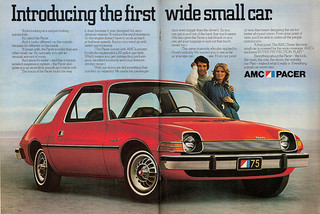
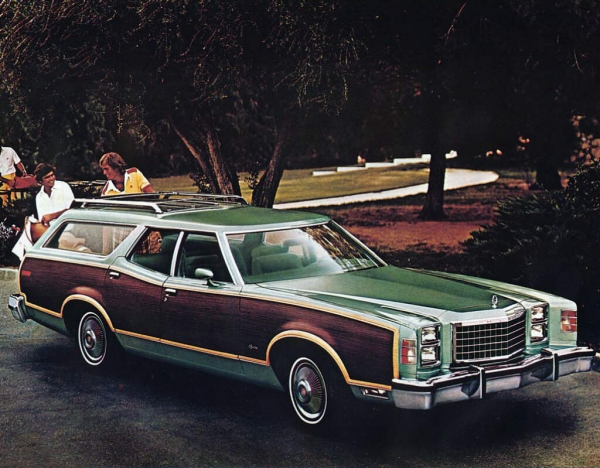 you were a racer! A Parking Lot Drags race pitted two cars against each other at a time. They would appear from the pit area and draw up next to each other as they passed the stands. They would circle the track once, and the race would begin once they crossed the Start/Finish Line. The race lasted one lap.
you were a racer! A Parking Lot Drags race pitted two cars against each other at a time. They would appear from the pit area and draw up next to each other as they passed the stands. They would circle the track once, and the race would begin once they crossed the Start/Finish Line. The race lasted one lap.
Often, the cars had no business being on a race track. The announcer would play it up: “Let’s hear it for Tony Howard in his red, AMC Pacer! His opponent is young Johnny Wojciechowski! Today, Johnny will be racing his father’s brand new, 1977 Ford LTD Station Wagon!!!” The crowd would hoot and holler: this guy needs to run into something!!
Spurred on by the cheering, the drivers’ competitive nature emerged. They drove their cars HARD. Tires squealed; the engines roared in low gear. The outside tires rolled under the car, and the inside tires bounced up and down as the drivers veered left through the turns. Spinning hub caps sprung from the wheels and rolled quite a ways along the track. And yes, there was the occasional, glorious collision. All for the deep, warm appreciation of a bloodthirsty crowd.
Decades later, I was among extended family and the Parking Lot Drags came up as a topic of conversation. My brother in law looked over at me. “I drove in that.” Seriously? Yep. As a teenager, Clint and some friends bought an old, beat up car together for the sole purpose of using it at Painesville Speedway. They all worked on it, and he drove it. Who knows, I may have watched him race. Awesome. I knew I liked that guy.
***
At its core, the Joie Chitwood Thrill Show was a family affair. Joie, Sr. had been a scuffling, Depression-era teenage dropout who was looking for work in 1930s, dust-bowl Kansas. A series of events led him to a position as a welding apprentice. In turn, a door opened for him on an auto racing team. When the driver complained too much about the handling of the car, the owner removed him and installed Chitwood. By 1940, at age 28, he was driving in the fabled Indianapolis 500. Chitwood was a legitimate Indy car driver, finishing in the top five three times by his last race, in 1950.
Joie Chitwood, Sr.’s Indianapolis 500 legacy would include two innovations, as well. He was the first driver to use a seat belt. It wasn’t for safety; in fact, conventional wisdom at the time held that it was safer to be thrown from a vehicle in a crash than it was to be strapped inside. His reason for using the belt was to help hold him still while rattling around the brickyard. It was for improved handling. The other innovation was one he was indirectly responsible for: in one of his fifth-place finishes, photos produced the next day showed he’d actually crossed the finish line in second place. Thereafter, official results were not posted until the day after the race.
During the World War II years of the early 1940s, Joie Chitwood, Sr. was 4F (disqualified from military service due to physical reasons). Racing was outlawed due to the 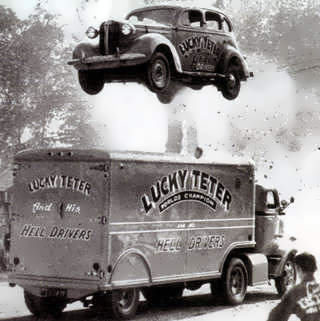 country’s need of rubber and fuel for the war effort. It was during this time that Chitwood met the widow of stunt driver Lucky Teter.
country’s need of rubber and fuel for the war effort. It was during this time that Chitwood met the widow of stunt driver Lucky Teter.
Teter had performed a ‘thrill show’, driving and jumping cars. With his charismatic delivery, the promoter would get the crowd worked up. He would exhort them into cheering loudly, as it could be the last time! Teter would dramatically wave a handkerchief to the crowd, and his wife would approach him for a ‘farewell’ kiss. As it turned out, it was during a jump that he was killed (it was said he had his military papers in his pocket; he was to be going off to war. A huge gathering of family and friends were on hand to see the last jump). Mrs. Teter asked Chitwood to sell off Teter’s equipment, and the race car driver agreed.
Meanwhile, Chitwood’s wife wanted him to give up racing. He had been earning a nice 1942 salary of $40,000/yr, which was hard to let go. Since racing was now illegal, however, he gave thrill riding a try.
He purchased Lucky Teter’s equipment, giving him a supply of tires until they wore out. He began substituting them with studded steel wheels, and using butane gas instead of gasoline. Teter had not left behind his calculations and measurements for his jumps, so Chitwood began a process of trial-and-error in figuring speeds and distances between ramps. He smashed several old junkers in the process.
Chitwood had some of Teter’s ramps- and made one significant modification. Teter had been killed when a support beam shot through the windshield when he fell short of a ramp. Chitwood changed the design so the support beams ran side-to-side rather than front-to-back.
When the war ended, Joie Chitwood’s Thrill Show rocketed in popularity. Several teams performed in various towns at the same time. He hired Lucky Teter’s drivers, and they all performed Teter’s stunts. They traveled with their own announcer, and Chitwood even hired a clown who had performed in the old Buffalo Bill western show.
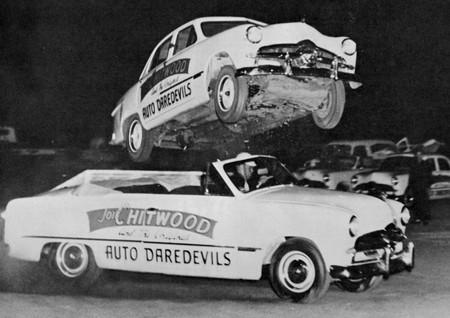 Soon, they branched out: one particular crowd-pleaser was the crash of an airplane. A war pilot was hired, and the U.S government supplied Chitwood with cheap, worn out planes. Telephone poles would be erected in the infield. The pilot would navigate the plane over the lights and down to the field, toward the stands. He would crash land, sliding between the poles, which would tear the wings off the plane. It was a huge hit, until the authorities outlawed the practice (they were concerned with the image of manned flight).
Soon, they branched out: one particular crowd-pleaser was the crash of an airplane. A war pilot was hired, and the U.S government supplied Chitwood with cheap, worn out planes. Telephone poles would be erected in the infield. The pilot would navigate the plane over the lights and down to the field, toward the stands. He would crash land, sliding between the poles, which would tear the wings off the plane. It was a huge hit, until the authorities outlawed the practice (they were concerned with the image of manned flight).
The show evolved over time, but Joie Chitwood’s cars were always Chevrolets. Fleets of sedans gave way to Corvairs, Camaros, Chevettes and SUVs. The Chevy sponsorship enabled him to perform over several decades- competitors always popped up, but were underfunded. Whereas Lucky Teter publicly celebrated the spectre of death, Joie Chitwood’s show focused more on the precision of stunt driving. Replacing the farewell kiss from the wife was the line of fellow stuntmen who wished the driver good luck with a handshake. Stunts included jumping over another car that passed below; rolling cars over; riding on two wheels; two cars riding in line with each other nose-to-nose, and the front car doing a 180 degree turn and continuing without a pause. Variations were introduced. Riders climbed out of cars and stood on top during the two wheel car ride. Motorcycle riders would jump forward just as the bike hit an oncoming car; the rider would clear the 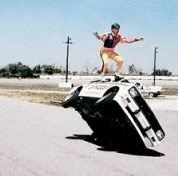 car and hop to the ground. The human battering ram was a favorite, using Joey Jr. – and eventually, a young Joie III- strapped to the hood of a car as it rammed through a wall. Often, stunts included fire. Invariably, the cars streaked back to the stands and side-skidded to parallel stops, with the drivers hopping out in one motion and saluting the crowd.
car and hop to the ground. The human battering ram was a favorite, using Joey Jr. – and eventually, a young Joie III- strapped to the hood of a car as it rammed through a wall. Often, stunts included fire. Invariably, the cars streaked back to the stands and side-skidded to parallel stops, with the drivers hopping out in one motion and saluting the crowd.
The star attraction of the show- the final act- was the rocket tube jump. Chitwood had fabricated the tube in an old Pennsylvania barn, and it was used for decades. There was little margin for error: the angle of the tube needed to be just right, as did the speed (42mph) and aim of the approaching car. As the car emerged from the ramp, a nearby teammate manually detonated an explosion, to make it appear the car rocketed from the tube. ‘Perfect’ jumps occurred maybe ten times a year. Meaning, the car landed quietly, with all four wheels touching down simultaneously. The rest of the jumps were all ‘good’. Meaning, “a jump you walk away from.”
For most of the show's half-century run, there was typically one performance per day. The traveling party, which included families, usually slept in their cars for the 200-show season. This, they would say, was the toughest part. The constant moving- not the danger. The drivers did not practice; the stunts were repetitive, and anyway, if there was going to be a crash, it might as well happen during a show!
The stunts affected some more profoundly than others. To a kid like myself at Painesville Speedway, the Chitwood show created some wonderment, and fun memories. 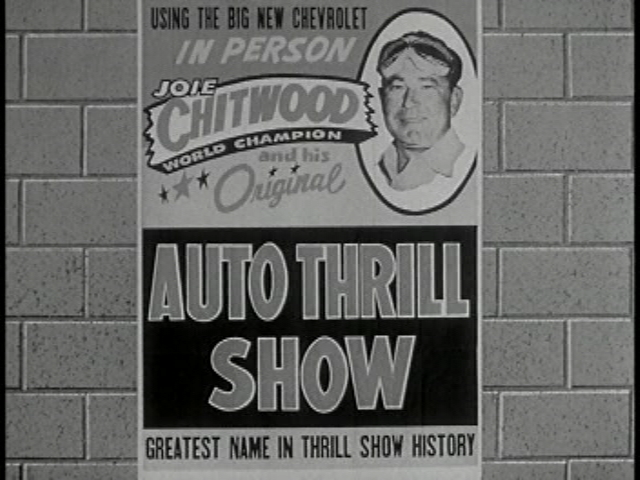
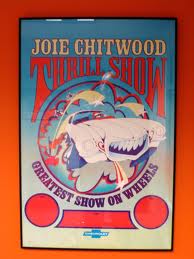 A Montana kid named Robert Craig (“Evel”) Knievel would one day claim that the show inspired a life of motorcycle jumping. The show drew to a close in 1999.
A Montana kid named Robert Craig (“Evel”) Knievel would one day claim that the show inspired a life of motorcycle jumping. The show drew to a close in 1999.
The legacy lives on with Joie III, now in his mid 40s. Not in stunt riding, however. He earned his MBA in 1995, brazenly writing letters to Tony George (Indy mogul) and Bill France (NASCAR top man) as he sought positions in racing management. He did some Indy Racing League work with George, parlaying that into a career in NASCAR. France was intrigued by Joie III’s street-smart exposure in small-town deal-making. France knew that serving the interest of several parties in such deals was experience was something that most racing executives did not have. Joie III became the head man at the Chicagoland track, before moving on to become president of the Indianapolis Motor Speedway- where his grandfather first raced in 1940. The boy who started out doing 180s in a go-kart on race tracks at age 5 is now the president of Daytona.
Thank you for reading. Sources included Wheelbase Communications, Jason Stein; Jacksonville.com, Don Coble; Sports Illustrated, Frank Deford; racintoday.com, Larry Woody; The Reading Eagle, 1/4/1988, also Ron Devlin; Hemmings.com, Jim Donnelly; chicagotribune.com, Skip Myslenski; Nascar.speedtv.com, Mike Hembree.
Please check out these videos.
A long video, with lots of clips and interviews. Some Lucky Teter in there too.
A 1970s shock absorber commercial, shown during the telecast of a Kneivel jump.
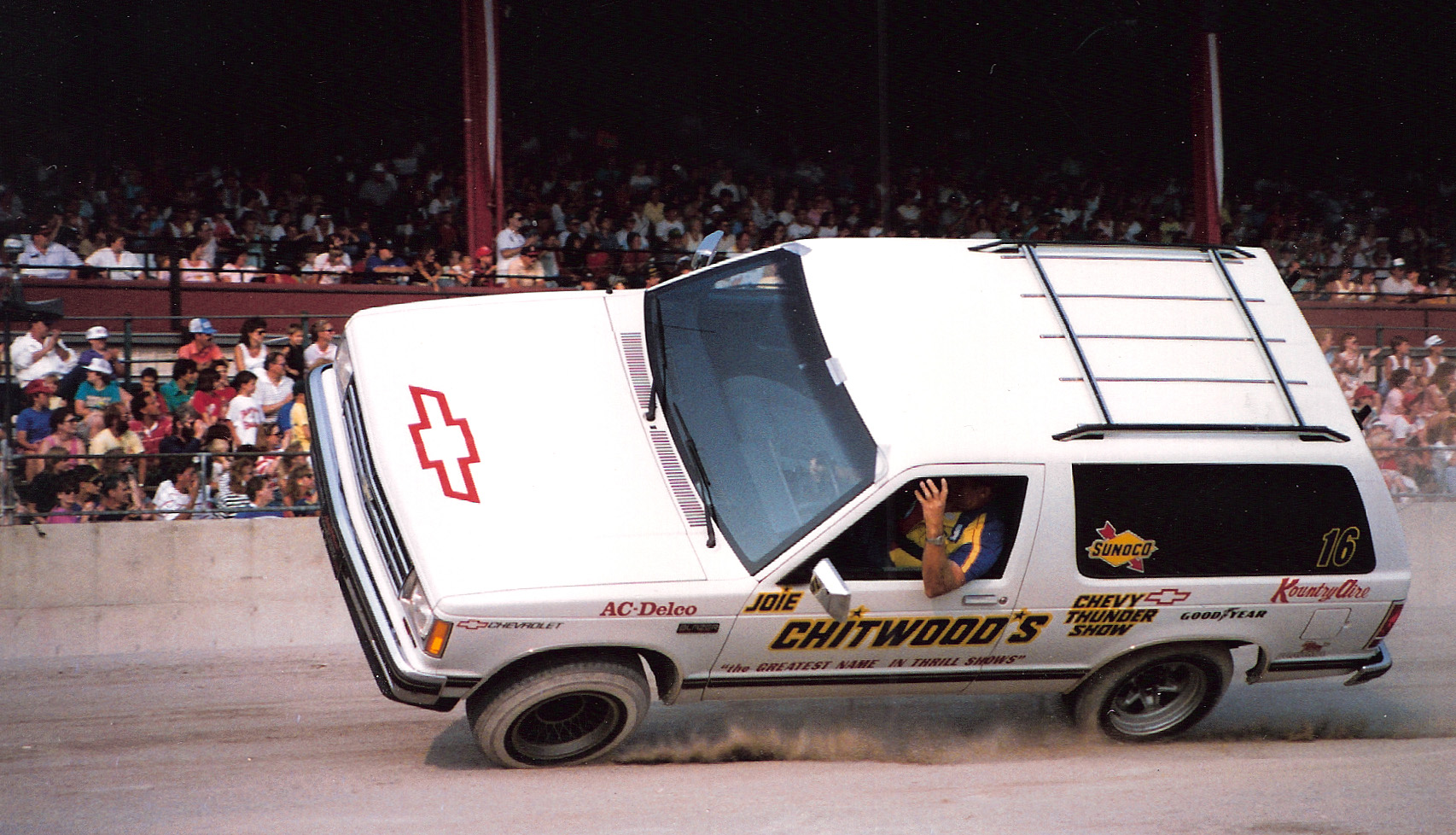
- NBA Announces 2013-2014 Schedule
- Browns Ink Sharknado
- Sharknado A No-Show For Rookie Camp
- Trent Richardson Out Until Training Camp
- Browns Sign Brandon Jackson
- Carrasco Suspended Eight Games
- Browns Add to Wide Receiver Depth with David Nelson
- Browns Need to Learn from Past Draft Mistakes
- Browns Release Chris Gocong and Usama Young
- Browns Missing on Grimes Disappointing, But Not The End
The TCF Forums
- Official- Browns Coach Search/Rumors
mattvan1 (Tuesday, January 21 2014 1:19 PM) - Movies coming out
rebelwithoutaclue (Tuesday, January 21 2014 12:56 PM) - 2015 Recruiting
jclvd_23 (Tuesday, January 21 2014 12:38 PM) - The 2014 Offseason Thread
Larvell Blanks (Tuesday, January 21 2014 12:25 PM) - Chris Grant's first 3 drafts
Kingpin74 (Tuesday, January 21 2014 10:13 AM) - Mike Brown
YahooFanChicago (Monday, January 20 2014 11:15 PM) - 2014 Hoops Hockey Hijinx
jpd1224 (Monday, January 20 2014 4:44 PM) - 2014 Recruiting
jclvd_23 (Monday, January 20 2014 2:26 PM) - Wish List - #4 Pick
Hikohadon (Monday, January 20 2014 1:26 PM) - #1 overall pick Anthony Bennett
TouchEmAllTime (Sunday, January 19 2014 1:28 PM)



